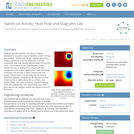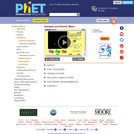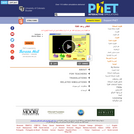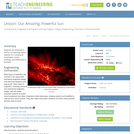
8 Results


Students' eyes are opened to the value of creative, expressive and succinct visual presentation of data, findings and concepts. Student pairs design, redesign and perform simple experiments to test the differences in thermal conductivity (heat flow) through different media (foil and thin steel). Then students create visual diagrams of their findings that can be understood by anyone with little background on the subject, applying their newly learned art vocabulary and concepts to clearly communicate their results. The principles of visual design include contrast, alignment, repetition and proximity; the elements of visual design include an awareness of the use of lines, color, texture, shape, size, value and space. If students already have data available from other experiments, have them jump right into the diagram creation and critique portions of the activity.
- Subject:
- Applied Science
- Business and Communication
- Communication
- Engineering
- Material Type:
- Activity/Lab
- Provider:
- TeachEngineering
- Provider Set:
- TeachEngineering
- Author:
- Andrew Carnes
- Baratunde Cola
- Jamila Cola
- Satish Kumar
- Date Added:
- 10/14/2015

Are all atoms of an element the same? How can you tell one isotope from another? Use the sim to learn about isotopes and how abundance relates to the average atomic mass of an element.
- Subject:
- Chemistry
- Physical Science
- Material Type:
- Simulation
- Provider:
- University of Colorado Boulder
- Provider Set:
- PhET Interactive Simulations
- Author:
- Emily Moore
- John Blanco
- Kathy Perkins
- Kelly Lancaster
- Robert Parson
- Sam Reid
- Trish Loeblein
- Date Added:
- 07/18/2011

Are all atoms of an element the same? How can you tell one isotope from another? Use the sim to learn about isotopes and how abundance relates to the average atomic mass of an element.
- Subject:
- Chemistry
- Physical Science
- Material Type:
- Simulation
- Provider:
- University of Colorado Boulder
- Provider Set:
- PhET Interactive Simulations
- Author:
- Emily Moore
- John Blanco
- Kathy Perkins
- Kelly Lancaster
- Patricia Loblein
- Robert Parson
- Sam Reid
- Date Added:
- 05/13/2011

The purpose of this lesson is to introduce the students to the Sun. They explore various aspects of the Sun including its composition, its interior workings, and its relationship to the Earth.
- Subject:
- Applied Science
- Astronomy
- Engineering
- Physical Science
- Material Type:
- Activity/Lab
- Lesson Plan
- Provider:
- TeachEngineering
- Provider Set:
- TeachEngineering
- Author:
- Brian Kay
- Geoffrey Hill
- Janet Yowell
- Jessica Butterfield
- Jessica Todd
- Date Added:
- 09/18/2014

Our Patterns Chemistry development team of teacher leaders has been working hard through the spring and summer of 2020 to develop distance learning versions of the Patterns Chemistry units. Between March and May they released the below Distance Learning versions of units 4, 5 and 6, as well as paper packets that can be printed for students who do not have access to technology at home. Below are the distance learning version of units 1 and unit 2. The distance learning units can be used in either a fully online or hybrid school model. A Distance Learning version of Unit 3 will be released by the end of September. For schools reopening fully in person, scroll down to see the original Patterns Chemistry unit plans.
- Subject:
- Chemistry
- Physical Science
- Material Type:
- Activity/Lab
- Lesson Plan
- Author:
- Portland STEM Partnership
- Date Added:
- 09/03/2020

THE PATTERNS APPROACH
The Patterns Approach to science instruction emphasizes the use of mathematical and phenomenological patterns to predict the future and understand the past. Students construct science knowledge by making an initial “wild-guess”, asking questions, planning and conducting experiments, collecting data, finding a mathematical model that fits their data, explaining the phenomenon based on that model, then finally making a data-informed prediction. Harnessing their own experiences, students compare and contrast low-evidence predictions (wild guesses) to their data-informed prediction to live the experience and learn the value of evidence-based reasoning. Additionally, students engage in several engineering projects in each course, where they must use the Patterns they discover in their designs to optimize their solutions. The Patterns Approach utilizes technology, student-constructed knowledge, frequent opportunities for student talk, and language supports to ensure the engagement and success of every student. By emphasizing, rather than removing, the mathematical connections to science, the Patterns Approach supports student conceptual understanding by connecting real-world inquiry experiences, graphical representations, and mathematical representations of science phenomena.
- Subject:
- Physical Science
- Physics
- Material Type:
- Activity/Lab
- Lesson Plan
- Author:
- Portland STEM Partnership
- Date Added:
- 08/10/2020

Students learn the value of writing and art in science and engineering. They acquire vocabulary that is appropriate for explaining visual art and learn about visual design principles (contrast, alignment, repetition and proximity) and elements (lines, color, texture, shape, size, value and space) that are helpful when making visual aids. A PowerPoint(TM) presentation heightens students' awareness of the connection between art and engineering in order to improve the presentation of results, findings, concepts, information and prototype designs. Students also learn about the science and engineering research funding process that relies on effective proposal presentations, as well as some thermal conductivity / heat flow basics including the real-world example of a heat sink which prepares them for the associated activity in which they focus on creating diagrams to communicate their own collected experimental data.
- Subject:
- Applied Science
- Engineering
- English Language Arts
- Material Type:
- Lesson Plan
- Provider:
- TeachEngineering
- Provider Set:
- TeachEngineering
- Author:
- Andrew Carnes
- Baratunde Cola
- Jamila Cola
- Satish Kumar
- Date Added:
- 10/14/2015